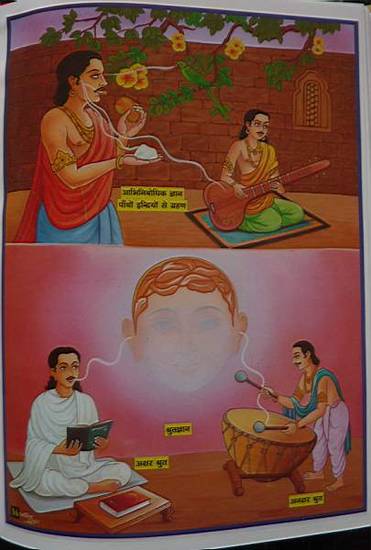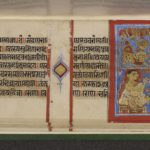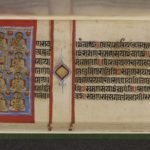Article: Cūlika-sūtras
The name cūlikā – ‘appendices’ – has become a common generic term for two particular texts in the Śvetāmbara canon. The Nandī-sūtra and the Anuyogadvāra-sūtra are treated separately from other groups of scriptures because they provide a methodological and ‘epistemological context’ (Dundas 2002: 76) for the whole canon.
The word ‘appendix’ suggests that they come at the end. But this is slightly misleading, as the Nandī-sūtra is often said to come first of all Śvetāmbara holy writings because of its contents. The two Cūlikās complement each other in focusing on different aspects of the concept of knowledge, a crucial theme for Jains. Correctly understanding the truth is a necessary forerunner of behaving properly, which, in turn, is required for spiritual progress towards final liberation from the cycle of rebirth. The Nandī-sūtra discusses the five types of knowledge, particularly the two ‘indirect’ kinds. The Anuyogadvāra-sūtra is a technical treatise on analytical methods, a kind of guide to applying knowledge. These twin texts underscore the central status of the Jain concept of anekānta-vāda, which emphasises how meaning is nuanced and how there are many different ways of interpreting something. From this point of view, the Cūlikās can be considered to come before the other scriptures.
Like most other texts of the Śvetāmbara canon, the Cūlikās are written in a combination of Ardhamāgadhī and Jaina Māhārāṣṭrī Prakrit.
Titles and subjects
To some extent, these ‘appendices’ – the two cūlikā texts – can be considered to run in parallel with one of the main Digambara scriptures, the Ṣaṭkhaṇḍāgama. All these writings:
-
share methodological concerns
-
develop the notion of parameters and methods that can be used to analyse complex concepts from multiple angles.
The approach of considering different factors so as to bring out the multiple shades of meaning of a term or notion is, in a way, anekānta-vāda. Central to Jain thinking, this concept of many-sidedness – in opposition to the idea of a single, absolute meaning – can be applied to virtually everything.
|
Prakrit title |
Sanskrit title |
|---|---|
|
Nandi-sutta |
Nandī-sūtra |
|
Aṇuogaddārāiṃ |
Anuyogadvāra-sūtra |
‘Nandī-sūtra’
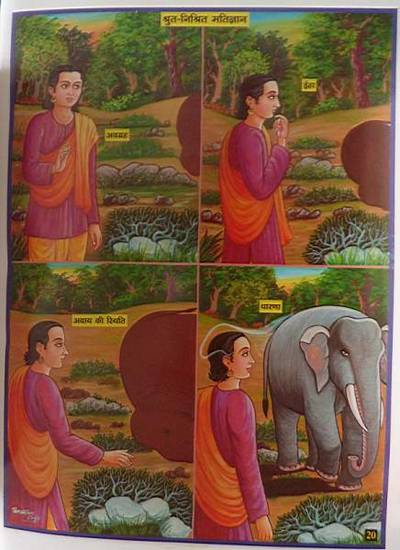
Stages of knowledge
Image by Diwakar Prakashan / Padma Prakashan © Diwakar Prakashan / Padma Prakashan
The Sanskrit term nandī conveys an idea of delight. It is also a technical term in Sanskrit drama for the first stanza of a play, which pays homage to one of the gods. The Nandī-sūtra of the Śvetāmbara canon, which is written in prose and verse, may be regarded as an auspicious beginning from several angles. Indeed, Muni Puṇyavijaya writes that ‘It has secured the position of an auspicious introductory prayer in the beginning of Āgamavācana [the words of the Canon]’ (1968: Introduction p. 31).
According to the Śvetāmbara tradition, the Nandī-sūtra is the work of ‘Devavācaka’, who was the pupil of Dūsa-gaṇi. It is likely that this is the predecessor or the same person as Devarddhi-gaṇi, who oversaw the final redaction of the Śvetāmbara canon during the fifth century. The Nandī-sūtra appears to collect together materials that are partly found elsewhere in the canon.
It discusses the concept of knowledge, which is a vital topic for Jains because proper understanding underpins correct behaviour and, thus, spiritual advance towards liberation.
Introductory matter
The Nandī-sūtra starts with verses of homage to:
These verses are the usual auspicious formulas found at the beginning of most Jain texts.
The celebration of the community is expressed through images with which it is associated. Many of these images are significant in wider Indian culture, but they all underline the central importance of the notion of community. Symbols linked with community for Jains include:
- city
- wheel
- chariot
- lotus
- moon
- sun
- sea
- mountain.
After these standard introductory elements comes a praise of Mahāvīra’s disciples and the elders who succeeded them. These early Jain teachers are named and celebrated in successive verses. This is what is technically known as Sthavirāvalī or, in the Prakrit form, Therāvalī. Other examples familiar to Śvetāmbara Jains are the second section of the Kalpa-sūtra and the preamble to the Āvaśyaka-niryukti, the fourth Mūla-sūtra.
The list of elders starts with Sudharman and Jambū and closes with Duṣya-gaṇi. Nothing is known about him, but he may have been the predecessor of Devarddhi-gaṇi. This teacher is known as the redactor of the Śvetāmbara canon during the fifth-century council at Valabhī, Gujarat.
One stanza then lists metaphorical terms for the two categories of audience members. Using 14 mnemonic terms the listeners are contrasted as:
- those who are worthy of receiving teaching because they will pay attention and benefit from it
- those who are unworthy of it.
Each of the terms is explained in the commentaries to the Nandī-sūtra as well as in those on the Āvaśyaka-niryukti, where the same stanza is found (Balbir 1993). For instance, the term:
- ‘mosquito’ means a bad pupil because he may learn something, but will inflict pain on his teacher
- ‘sieve’ is the pupil who does not retain anything he has heard.
Knowledge

Shapes of the Bhavanapati gods’ clairvoyance
Image by British Library © CC0 1.0 (Creative Commons Public Domain)
The heart of the Nandī-sūtra deals with the concept of cognition or knowledge in its various divisions and subdivisions. This is also an appropriate topic for a text that transcends all categories in the Śvetāmbara canon, for it can be regarded as a prerequisite to the scriptures.
First comes the list of the five types of knowledge, known from other sources as well, such as the Tattvārtha-sūtra I. 9–33
|
Prakrit form |
Sanskrit form and other names |
English equivalent |
|
|---|---|---|---|
|
1 |
abhiṇibohiya-nāṇa |
abhinibodhika-jñāna or mati-jñāna |
perception or insight |
|
2 |
suya-nāṇa |
scriptural knowledge or, more broadly, knowledge from what is heard |
|
|
3 |
ohi-nāṇa |
clairvoyance |
|
|
4 |
maṇa-pajjava-nāṇa |
telepathy |
|
|
5 |
kevala-nāṇa |
The first two types of knowledge are achieved indirectly – parokkha in Prakrit, parokṣa in Sanskrit – that is, through the five sense-organs and through the mind. The last three kinds of knowledge are defined and dealt with as achieved directly – Prakrit paccakkha, Sanskrit pratyakṣa. This means ‘without the aid of the sense-organs and the mind and on the basis of the capacity of a soul alone’ (Pandit Sukhlalji, Tattvārthasūtra 1974: 20).
Perception or insight
The first variety of cognition, which combines the functions of the five senses with the mind, is itself subdivided into four kinds. These define four types of intelligence or proficiency in general, outside Jain doctrine.
|
Prakrit form |
Sanskrit form |
English meaning |
|
|---|---|---|---|
|
1 |
uppattiyā buddhi |
autpattikī buddhi |
spontaneous intelligence not based on anything heard or seen before |
|
2 |
veṇaiyā buddhi |
vainayikī buddhi |
intelligence coming from humility or modest behaviour |
|
3 |
kammayā buddhi |
karmajā buddhi |
practical intelligence or proficiency coming from mastering a technique |
|
4 |
pāriṇāmiyā buddhi |
pāriṇāmikī buddhi |
deductive intelligence |
No definition of these classes is given in the text. Instead, several verses list mnemonic words referring to examples of story characters who display a given type of intelligence. The elaborate stories featuring these individuals are transmitted in the commentaries on the Nandī-sūtra and even more in the Āvaśyaka-niryukti and its commentaries, where they occupy several pages. These stories are very popular with later Jain authors as well, who give renderings in their own words, whether in Prakrit, Sanskrit or the vernaculars.
Abhaya-kumāra, the minister to King Śreṇika of Magadha, features among those famous for their spontaneous cleverness, the first type of indirect knowledge. A kind of common sense based on observation, this enables him to solve apparently impossible situations, contradictions or riddles. Judges, who are able to solve disputes over ownership between litigants, using visible evidence, are other examples of this ability. Jain versions of the story of Solomon’s judgement fall into this group, as do many other stories in Indian or even world folklore.
Then the four thought processes relating to perception are listed and defined:
- broad grasp of an idea – avagraha
- interrogation and reflection – īhā
- gradual arrival at some conclusion – avaya
- conclusive decision – dhāraṇā.
Comparable divisions are found in the Tattvārtha-sūtra I. 15.
Scriptural knowledge
Next, the Nandī-sūtra deals with the topics of scriptural knowledge and its various divisions at length.
The Sanskrit term śruta-jñāna is first understood in the broadest meaning of knowledge of something that is heard. Hence the first division is between non-language and language sounds. The former refers to musical instruments, the latter to words articulated by a human voice.
The human voice has always been important in transmitting the principles of Jainism. A Jina emits the divine sound containing his message, which his disciples shape into the Jain teachings. These were passed on orally for centuries before being written down as the scriptures. Listening to and understanding a teacher reading from or reciting passages from the scriptures is still an important part of being a Jain, whether mendicant or lay.
There are several important oppositions given in the text, some of which are listed in this table.
|
Prakrit form |
Sanskrit form |
English meaning |
Examples |
|
|---|---|---|---|---|
|
1 |
samma-suya |
samyak-śruta |
right scriptural knowledge |
|
|
|
miccha-suya |
mithyā-śruta |
wrong scriptural knowledge |
|
|
2 |
anga-paviṭṭha |
aṅga-praviṣṭa |
what is ‘inside the Aṅgas’ |
The Aṅga scriptures, which are described in turn. |
|
|
anga-bāhira |
aṅga-bāhira |
what is ‘outside the Aṅgas’ |
|
|
3 |
ukkāliya |
utkālika |
related to when to study scriptures |
|
|
kāliya |
kālika |
related to when to study scriptures |
|
Direct types of knowledge
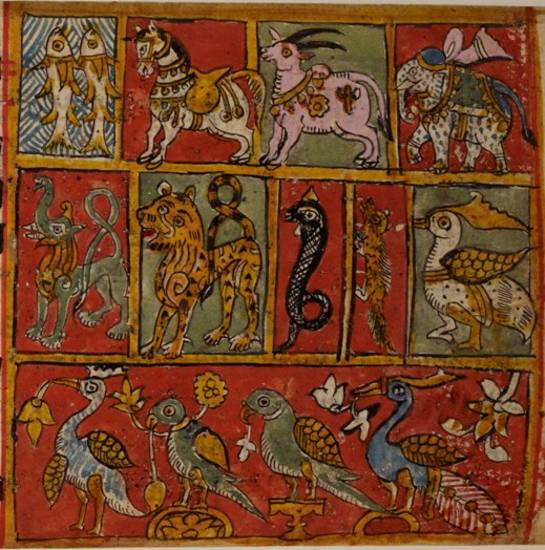
Five-sensed animals
Image by British Library © CC0 1.0 (Creative Commons Public Domain)
The last three kinds of knowledge go by the Prakrit term paccakkha or the Sanskrit term pratyakṣa. These kinds of knowledge can be gained from having the capacity for a soul, and do not depend on the senses or mind. They are:
- clairvoyance – avadhi-jñāna
- telepathy – manaḥ-paryāya-jñāna
- omniscience – kevala-jñāna.
Clairvoyance and telepathy are partly direct, whereas omniscience is totally direct. Gaining these kinds of knowledge requires an increasing degree of purity in mind and conduct. Omniscience is acquired only with perfect purity.
The Nandī-sūtra describes these classes of knowledge in relationship to their prerequisites and possessors. The attributes, durations and scopes of these kinds of knowledge are defined as well, in technical detail.
There are various types of clairvoyance. When considered to relate to one’s own condition – bhava-pratyaya – it is manifested in gods and hell-beings. Humans and animals with five senses can achieve clairvoyance resulting from the ending and destruction of karmas – kṣayopaśama – from ascetic practices.
Telepathy is acquired only by human beings born in the lands of the Jain universe where karma prevails – the karma-bhūmis. This means humans born in the Lands of Enjoyment – bhoga-bhūmi – where the notion of spiritual progress is irrelevant, cannot achieve it. This knowledge implies the possession of right faith – samyag-darśana – and a life of self-control, such as the one led by Jain ascetics. This type of knowledge is divided into various sub-categories depending on what it enables the individual to grasp, such as matter, space or time.
Omniscience is the ability of the soul to grasp everything everywhere relating to past, present and future all at once. It is achieved only when all possible varieties of karmas have been totally destroyed so that total purity is reached.
‘Anuyogadvāra-sūtra’
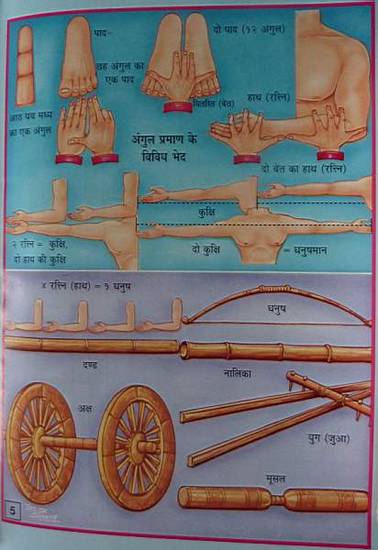
Units of measurement
Image by Diwakar Prakashan / Padma Prakashan © Diwakar Prakashan / Padma Prakashan
In Muni Puṇyavijaya’s words, ‘the Nandi which is of the form of five Jñānas serves as a mangala in the beginning of the study of the Āgamas; and the Anuyogadvāra-sūtra serves as a key to the understanding of the Āgamas’ (1968: Introduction p. 45). The second Cūlikā is highly technical and not easy to summarise. It can be described as dealing with methods of analysis, providing examples that the reader can use when approaching similar situations in the literature.
Its title can be understood as meaning ‘the doors of exposition’. This stresses that the text focuses on the ways of approaching and understanding concepts. There are four doors:
- commencement – upakrama
- position – nikṣepa
- exposition of concepts and their application in different contexts – anugama
- exposition of different aspects viewed from different angles – naya.
Here, the subject is the concept of ‘necessary duties’ – āvaśyaka. However, out of a total of six, only the first one – ‘equanimity’ or sāmāyika – is treated. The reason is that the Anuyogadvāra is concerned with analytical procedures, not with content or meaning. Hence the first one is taken as an example of a method of analysis.
Such a method implies, for instance:
- explaining in detail the title of a work, chapter or section
- listing synonyms or equivalents of the term to be explained
- considering this term using a list of given parameters – nikṣepa.
This nikṣepa consists of:
This approach is widely found in the Prakrit verse-commentaries, the niryuktis, to which the Anuyogadvāra-sūtra is rather close in spirit.
In the course of the development of a topic, many technical matters are also treated, which relate to:
- measures of space and time, from indefinitely small to indefinitely enormous
- numbers
- quantities
- mathematical concerns in general.
These analyses are motivated by the term anupūrvī – ‘serial sequences’ – which is another understanding of the term ‘commencement’. Hence the Anuyogadvāra-sūtra is also of interest to historians of computation and mathematics in ancient India.
Historians of other areas of knowledge also find interesting material in this text, some of which is presented in the table.
|
Topic |
Detail |
|---|---|
|
grammar |
grammatical congruence in gender or number
|
|
music |
discussion of the seven musical notes – svara – including:
|
|
poetics and dramaturgy |
unique list and description of the ‘nine sentiments’ – nava rasas:
|
|
astrology and prediction |
discussion of elements of physiognomy and prophecy on the basis of observation of signs in the sky |
Commentaries
These two works have been the subject of many commentaries over the centuries, like other categories of the Śvetāmbara canon. The Cūlikās, however, have not attracted all kinds of commentary. Surviving types of commentary that focus on them are:
- the Prakrit prose commentaries – cūrṇis – written over the sixth to seventh centuries by a certain Jinadāsa, about whom nothing much is known
- the Sanskrit commentaries.
|
Cūlikā |
Prakrit prose commentary |
Sanskrit commentary |
|---|---|---|
|
Nandī-sūtra |
cūrṇi by Jinadāsa |
by Malayagiri in the 12th century |
|
Anuyogadvāra-sūtra |
cūrṇi by Jinadāsa |
by Hemacandra Maladhārin in the 12th century |
Reading
- Kleine Schriften
Walther Schubring - edited by Klaus Bruhn
Glasenapp Stiftung series; volume 13
Franz Steiner Verlag GmbH; Wiesbaden, Hesse, Germany; 1977
- Āvaśyaka-Studien: Introduction générale et traductions
Nalini Balbir - Alt- und Neu-Indische Studien series; volume 45: 1
Franz Steiner Verlag; Stuttgart, Baden-Württemberg, Germany; 1993
- ‘On the role and meaning of the Śvetāmbara canon in the history of Jainism’
Nalini Balbir - Studies in Jaina History and Culture: Jaina Law
edited by Peter Flügel
Routledge Advances in Jaina Studies series; volume 4
Routledge Curzon Press; London, UK; 2013 – forthcoming
- The Canonical Nikṣepa: Studies in Jaina Dialectics
Bansidhar Bhatt - Indologia Berolinensis series; volume 5
Brill; Leiden, Netherlands; 1978
- ‘The Intellectual Formation of a Jain Monk: A Śvetāmbara Monastic Curriculum’
John E. Cort - Journal of Indian Philosophy
volume 29
2001
- The Jains
Paul Dundas - Library of Religious Beliefs and Practices series; series editor John Hinnels and Ninian Smart; volume 14
Routledge Curzon Press; London, UK; 2002
- The Jaina Path of Purification
Padmanabh S. Jaini - University of California Press; Berkeley, California USA; 1979
- ‘The tales belonging to the Namaskāra-vyākhyā of the Āvaśyaka-cūrṇi: A survey’
Adelheid Mette - Indologica Taurinensia
edited by Nalini Balbir and Colette Caillat
volume 11
International Association of Sanskrit Studies; 1983
- Stories of Abhayakumāra
Hampana Nagarajaiah - K. S. Muddappa Smaraka Trust; Bangalore, Karnataka, India; 2008
- The Doctrine of the Jainas: Described after the Old Sources
Walther Schubring - translated by Wolfgang Bühlen
edited by Satya Ranjan Banerjee
Lala Sunder Lal Jain Research series; volume 15
Motilal Banarsidass; New Delhi, India; 2000
- The “Śvetāmbara Canon.” A Descriptive Listing of Text Editions, Commentaries, Studies and Indexes: Based on Editions held in the Library of the Australian National University
Royce Wiles - unpublished; Canberra, Australia; 1997
- Historical Dictionary of Jainism
Kristi L. Wiley - Historical Dictionaries of Religions, Philosophies, and Movements series; series editor Jon Woronoff; volume 53
Scarecrow Press; Maryland, USA; 2004
Links
- Bodleian Library
-
The Bodleian Library is part of the University of Oxford, the official university library with various specialist libraries. It boasts extremely extensive collections of books, newspapers, magazines, journals, manuscripts, maps, musical scores, and official and personal papers, both ancient and modern. With large Jain holdings, the Bodleian is a JAINpedia partner.
- British Library
-
One of the JAINpedia partners, the British Library is the national library of the UK. Based in London, it holds millions of historical and contemporary documents of all kinds, including books, newspapers, magazines, journals, manuscripts, musical scores and political and personal papers and letters. It also has a large collection of sound recordings and illustrations. Its collection of Jain manuscripts is one of the biggest outside India.
- Victoria and Albert Museum
-
The V&A in London specialises in art and design. Its enormous collections include historical and contemporary sculptures, textiles, furniture, jewellery, photographs, drawings, books, prints, ceramics, glass- and metalwork, theatre and performance artefacts. It has extensive Asian holdings, including many illustrated Jain manuscripts, and is one of the JAINpedia partners.
- Wellcome Collection
-
Part of the Wellcome Institute, the Wellcome Collection is one of the JAINpedia partners. Its extensive collections include historical and contemporary books, manuscripts, prints, paintings, photographs and films, with a bias towards science and medicine. The Wellcome holdings of Jain materials are small but valuable and interesting.
- Jain eLibrary
-
The Jain eLibrary provides PDFs or other files of Jain texts to download for non-commercial purposes. Scriptures, commentaries, dictionaries, articles, magazines and books on all aspects of Jainism are available in many languages, including English and modern Indian languages. Most sects are represented and both ancient and contemporary works are included.
Only registered users who have signed into the site can download material. To register, you must provide a valid email address, a password and some personal details.
You will need to have Adobe Acrobat Reader on your computer to open PDF files.
- Centre of Jaina Studies, SOAS
-
The Centre of Jaina Studies at the School of Oriental and African Studies (SOAS) in the University of London, is the only academic centre specialising in Jain research outside India. Established in 2004, the centre hosts an annual conference for scholars of Jainism and publishes an annual newsletter and the International Journal of Jaina Studies (Online). It also runs undergraduate and postgraduate degrees in Jain studies.
- Royal Asiatic Society
-
Based in London, the Royal Asiatic Society of Great Britain and Ireland dates back to 1823, when it was founded to assist scholarly investigation into the history, cultures, religions and languages of Asia. The society has a large library, including an extensive manuscript collection, organises seminars and lectures, and publishes a journal three times a year.
- Bhogilal Leherchand Institute of Indology
-
The Bhogilal Leherchand Institute of Indology in New Delhi focuses on scholarly research into Śvetāmbara Jainism. With a library of manuscripts for research, it organises academic seminars and publishes scholarly books.
- Institut Français de Pondichéry
-
The French Institute of Pondicherry is a research centre of the French Ministry of Foreigh Affairs. Founded in 1955, it undertakes scholarly research and training in South and South-East Asia. The website is in English.
- Lalbhai Dalpatbhai Institute of Indology and Museum
-
Based in Ahmedabad, Gujarat, the Lalbhai Dalpatbhai Institute of Indology is a national centre affiliated to the National Mission for Manuscripts. With a library of manuscripts, it has a specific section for manuscript preservation and cataloguing. In addition to holding seminars for researchers into Śvetāmbara Jainism, the L. D. Institute publishes books and the Sambodhi journal in English, Hindi and Gujarati. The L. D. Museum, on the same site, holds an important collection of Jain artefacts – statues, manuscripts, the N. C. Mehta Collection of paintings and a gallery of monastic equipment that belonged to Muni Puṇyavijaya.
- Mahavir Aradhana Kendra – institute
-
Based around the pilgrimage site of Mahaviralaya – a temple dedicated to Mahāvīra, the last Jina – Mahavir Aradhana Kendra is a manuscript library and research institute, which publishes academic books, chiefly on Śvetāmbara Jainism. There is also a museum that includes the monastic equipment used by Gacchādhipati Ācārya Śrī Kailāsaāgara-sūrīśvara Mahārāj.
- Parshvanath Vidyashram Research Institute
-
The Parshvanath Vidyashram Research Institute focuses on research into Śvetāmbara Jainism. Based in Varanasi, in Uttar Pradesh, it has a manuscript library and publishes books and the Śramaṇ journal in Hindi and English.
- Indian universities with departments of Jain studies
-
Jainworld provides a list of Indian universities that have departments with researchers in or courses investigating aspects of Jainism.
- Jain research institutions in India
-
Jainworld provides a list of research institutions in India that focus on various aspects of Jainism.
- Jain Vishva Bharati University
-
Located in Ladnun, Rajasthan, the Jain Vishva Bharati University is closely associated with the Terāpanthin monastic order. It also offers programmes in academic fields besides Jain studies.
- Jain studies at Claremont Lincoln University
-
Enrolling students from 2011, Claremont Lincoln University in California, USA, focuses on the academic study of religions. It offers a programme of Jain studies in partnership with Jain organisations based primarily in North America.
- Centre of Jaina Studies Newsletter
-
The Centre of Jaina Studies in the School of Oriental and African Studies (SOAS), at the University of London, publishes an annual newsletter, which is available to download as a PDF. The newsletter features:
- articles
- summaries of research
- academic news
- book reviews
- reports of exhibitions
- otifications and reports of conferences and symposia.
You will need to have Adobe Acrobat Reader on your computer to open PDF files.
- Institute of Oriental Manuscripts
-
Based in St Petersburg, the Institute of Oriental Manuscripts holds 150 Jain manuscripts. The website gives full information in English about the history and work of this research institute, part of the Russian Academy of Sciences.
http://www.orientalstudies.ru/eng/index.php?option=com_content&task=view&id=46&Itemid=82
- +
- aAbhavya
- aAbhinandana
- aAbhiṣeka
- aĀcāra
- aĀcārāṅga-sūtra
- aĀcārya
- aAchalbhrata
- aAḍhāī-dvīpa
- aAdharma
- aAdho-loka
- aAdhyayana
- aAdvaita Vedānta
- aĀgama
- aAghātīya
- aAghātīya-karman
- aAgnibhuti
- aAgra
- aĀhāra
- aAhiṃsā
- aAhimsa Day
- aAjita
- aAjīva
- aAkampit
- aĀkāśa
- aAkbar the Great
- aAkṣaya-tṛtīyā
- aAlauddin Khalji
- aAlbert Einstein
- aAllah
- aAlms
- aĀlocanā
- aAloka-ākāśa
- aAmāri
- aAmbikā or Kūṣmāṇḍinī
- aAnagāra
- aAnanta
- aAnarthadaṇḍa
- aAnaśana
- aAnekānta-vāda
- aAṅga
- aAniconism
- aAnojjā
- aAntarāla
- aAntarāya-karma
- aAṇu
- aAṇu-vrata
- aAnukampā
- aAnuprekṣā
- aAnusvāra
- aApabhraṃśa
- aAparigraha
- aAra
- aĀrambha
- aĀrambhaja
- aĀratī
- aArdhamāgadhī Prākrit
- aArhaṃ
- aArhat
- aArśana-āvaraṇīya-karma
- aĀrta-dhyāna
- aĀryikā
- aĀryikā Jñānamati
- aĀśātanā
- aĀścarya
- aAscetic
- aAsceticism
- aAshram
- aAspiration
- aĀsrava
- aAṣṭa-maṅgala
- aAṣṭāpada
- aAstikāya
- aAstrolabe
- aAsura
- aAtheism
- aAticāra
- aAtiśayakṣetra
- aAtithisaṃvibhāgavrata
- aĀtma-vāda
- aĀtman
- aAuṃ
- aAurangzeb
- aAuspicious
- aAusterity
- aAvadhāna
- aAvadhi-jñāna
- aĀvaraṇī-yakarman
- aAvasarpiṇī
- aAvatāra
- aAvidyā
- aAxiom
- aĀyāga-paṭa
- aĀyambil
- aĀyu-karma
- aĀyurveda
- bBabur
- bBāhubali
- bBaladeva
- bBālāvabodha
- bBandha
- bBasadi
- bBazaar
- bBhadrankarvijay
- bBhagavant
- bBhaktāmara-stotra
- bBhakti
- bBhale
- bBharata
- bBhāṣā
- bBhāṣya
- bBhaṭṭāraka
- bBhāva
- bBhāva-pūjā
- bBhāvanā
- bBhavana-vāsin
- bBhavya
- bBhavyatva
- bBhaya
- bBhoga-bhūmi
- bBhogopabhoga
- bBodhi
- bBollywood
- bBrahmā
- bBrahma-deva
- bBrahmacārī
- bBrāhmaṇa
- bBraj Bhāṣā
- bBright fortnight
- bBritish Raj
- bBuddha
- bBuddhi-sagar
- bBuddhism
- bBuddhist
- cCaitya
- cCaityavāsin
- cCakravartin
- cCakreśvarī
- cCāmara
- cCandanā
- cCandragupta
- cCandraprabha
- cCanon
- cCāritra
- cCāritramohanīya-karman
- cCarũrī
- cCaste
- cCaturvidha-saṅgha
- cCaturviṃśati-stava
- cCāturyāma
- cCE
- cCelibacy
- cCha
- cChadmastha
- cChastity
- cCheda-sūtra
- cChristian
- cChristianity
- cClergy
- cCloning
- cColophon
- cCommentary
- cConch
- cConfession
- cCongregation
- cConsecration
- cCosmology
- cCremation
- cCrore
- cCult
- cCūrṇi
- dDādā-guru
- dDalit
- dDāna
- dDaṇḍa
- dDark fortnight
- dDarśana
- dDarśanamohanī-yakarman
- dDaśa-lakṣaṇa-parvan
- dDeity
- dDelhi Sultanate
- dDerāsar
- dDeśāvakāśika-vrata
- dDetachment
- dDevanāgarī
- dDevānandā
- dDevarddhi-gani
- dDevotee
- dDhamal
- dDhanuṣ
- dDhāra
- dDharma
- dDharma-dhyāna
- dDharma-sāgara
- dDharmastikaya
- dDhātakīkhaṇḍa
- dDholak
- dDhyāna
- dDiaspora
- dDig-vrata
- dDigambara
- dDīkṣā
- dDisciple
- dDīvālī
- dDivya-dhvani
- dDNA
- dDoctrine
- dDogma
- dDonor
- dDoṣa
- dDravya
- dDravya-pūjā
- dDrone
- dDuṣamā
- dDuṣamā-duṣamā
- dDuṣamā-suṣamā
- dDveṣa
- dDvīpa
- eEast India Company
- eEightfold Path
- eEkānta-vāda
- eEkendriya
- eElder
- eElders
- eEschatology
- eEtc up to
- fFarmān
- fFast
- fFatehpur Sikri
- fFestival
- fFestschrift
- fFiruz Shah
- fFly-Whisks
- fFolio
- fFour Noble Truths
- gGaccha
- gGaṇa
- gGaṇadhara
- gGanadharavada
- gGaṇeśa
- gGaṇin
- gGarba
- gGarbha
- gGarbha-gṛha
- gGaruḍa
- gGati
- gGene
- gGenomics
- gGhātī-yakarman
- gGhātīya
- gGhaznavid
- gGhiyasuddin Tughlaq
- gGhurid
- gGloss
- gGotra-karma
- gGujarāt
- gGujarati
- gGuṇa
- gGuṇa-sthāna
- gGuṇa-vrata
- gGupti
- gGuru
- gGuruṇī
- hHagiography
- hHajj
- hHaṃsa
- hHaribhadra
- hHariṇaigameṣin
- hHasta
- hHeresy
- hHiṃsā
- hHindi
- hHindu
- hHinduism
- hHīravijaya
- hHoroscope
- hHrīṃ
- hHumayun
- hHymn
- iIconoclasm
- iIconography
- iIdol
- iIndian Independence
- iIndology
- iIndra
- iIndrabhūti Gautama
- iIndriya
- iInitiation
- iIntercession
- iInvocation
- iIQ
- iIslam
- iIslamicate
- iIṣṭadevatā
- iĪśvara
- jJagat
- jJahangir
- jJain
- jJaina Devanāgarī
- jJaina Śaurasenī
- jJaina-dharma
- jJainaśāsana
- jJainness
- jJaisalmer
- jJamāli
- jJambū-dvīpa
- jJames Burgess
- jJanma
- jJanma-kalyāṇa
- jJarā
- jJāti
- jJina
- jJina-āgama
- jJina-bhavana
- jJina-bimba
- jJina-mātā
- jJinacandra-sūri
- jJinadatta
- jJinaprabha
- jJīva
- jJñāna
- jJñāna-āvaraṇīya-karma
- jJñāna-āvarṇiya
- jJñānsundar
- jJyotiṣka
- kKāla
- kKālakācārya-kathā
- kKālidāsa
- kKalpa-sūtra
- kKalpa-vṛkṣa
- kKalyāṇaka
- kKalyanvijay
- kKamaṇḍalu
- kKamaṭha
- kKarma
- kKarma-bhūmi
- kKarma-grantha
- kKarma-prakṛti
- kKarma-vāda
- kKarmon
- kKarnataka
- kKaṣāya
- kKathā
- kKāvya
- kKāya
- kKāyotsarga
- kKeśa-loca
- kKetu
- kKevala-jñāna
- kKevalin
- kKhalji
- kKharatara-gaccha
- kKnowledge
- kKriyā
- kKriyā-vāda
- kKṛṣṇa
- kKṣamā-śramaṇa
- kKṣapakaśreṇi
- kKṣatriya
- kKṣullaka
- kKulakara
- kKundakunda
- kKunthu
- lLabdhi
- lLaity
- lLakh
- lLāñchana
- lLands of Action
- lLaukāntika
- lLavaṇa-samudra
- lLeśyā
- lLiṅga
- lLinguistics
- lLoka
- lLoka-ākāśa
- lLoka-puruṣa
- lLoka-vāda
- lLotus
- lLotus lake
- mMadhya-loka
- mMahā-videha
- mMahā-vrata
- mMahābhārata
- mMahāmastakābhiṣeka
- mMāhārāṣṭra
- mMāhārāṣṭrī Prākrit
- mMahattarā Yākinī
- mMahāvīr Jayantī
- mMahāvīra
- mMakāra
- mMakkhali Gośāla
- mMalli
- mMāna-stambha
- mManaḥ-paryāya-jñāna
- mMaṇḍala
- mMaṇḍapa
- mMandit
- mMaṅgala
- mMantra
- mMantras
- mManuṣya-loka
- mMarāṭhī
- mMārgaṇā
- mMartyr
- mMarudevī
- mMaṭha
- mMati-jñāna
- mMauryaputra
- mMecca
- mMendicant lineage
- mMetarya
- mMiracle
- mMithyādṛṣṭi
- mMohandas Gandhi
- mMohanīya-karma
- mMokṣa
- mMonastic order
- mMonasticism
- mMonk
- mMonotheism
- mMosque
- mMount Meru
- mMount Sammeta
- mMṛgāvatī
- mMughal
- mMuhammad
- mMuhammad bin Tughlaq
- mMuhpattī
- mMūla-sūtra
- mMūlaguṇa
- mMumbaī
- mMuni
- mMunisuvrata
- mMurad Bakhsh
- mMūrti-pūjaka
- mMuslim
- mMysticism
- nNābhi
- nNāga-kal
- nNāgapurīya Tapā-gaccha
- nNāgarī
- nNāma-karma
- nNamaskāra-mantra
- nNami
- nNandīśvara-dvīpa
- nNandivardhana
- nNandyāvarta
- nNāraka
- nNāraki
- nNasalisation
- nNātha
- nNavrātrī
- nNaya-vāda
- nNemi
- nNidāna
- nniggaṃthāṇa vā 2
- nniggaṃtho vā 2
- nNigoda
- nNihnava
- nNikṣepa
- nNirgrantha
- nNirjarā
- nNirvāṇa
- nNiryukti
- nNiṣidhi
- nNitya
- nNiyati
- nNo-kaṣāya
- nNudity
- nNun
- oOcean of milk
- oOmniscience
- oOrdination
- ppa°
- pPadmaprabha
- pPadmāsana
- pPadmāvatī
- pPādukā
- pPalanquin
- pPalette
- pPañca-muṣṭi
- pPāṇḍava
- pPaṇḍit
- pPandit Dalsukh D. Malvania
- pPandit Sukhlalji
- pPāṇipātra
- pPāpa
- pParamātman
- pParameṣṭhin
- pPāraṇā
- pParigraha
- pPariṇāma
- pParīṣaha
- pParokṣa
- pPārśva
- pPārśvanātha
- pParyāya
- pParyuṣaṇ
- pPaṭa
- pPatan
- pPātra
- pPenance
- pPersian
- pPhala
- pPhilology
- pPicchikā
- pPilgrimage
- pPīr
- pPolymath
- pPoṣadha
- pPossession
- pPothī
- pPrabhas
- pPradakṣiṇā
- pPradeśa
- pPrākāra
- pPrakīrṇaka-sūtra
- pPrākrit
- pPramāda
- pPramukhā
- pPrati-vāsudeva
- pPratikramaṇa
- pPratimā
- pPratiṣṭhā
- pPratyākhyāna
- pPratyakṣa
- pPravacana
- pPrāyaścitta
- pPrayer
- pPre-modern
- pPreach
- pPredestination
- pProtestant
- pProvenance
- pPudgala
- pPūjā
- pPujārī
- pPukharavara-dvīpa
- pPuṇya
- pPūrva
- pPuṣkara-dvīpa
- pPuṣpadanta
- pPyre
- qQur’an
- rRāga
- rRāhu
- rRainy season
- rRajasthan
- rRajasthani
- rRājimatī
- rRajoharaṇa
- rRajput
- rRāma
- rRāmāyaṇa
- rRangoli
- rRās-garbā
- rRasa
- rRathanemi
- rRatna-traya
- rRātri-bhojana
- rRaudra-dhyāna
- rRecto
- rRelic
- rRenunciation
- rRetroflex
- rRevatī
- %Ṛg-veda
- rRite
- rRosary
- %Ṛṣabha
- %Ṛṣabhanātha
- rRupee
- sSaciyā Mātā
- sSādhu
- sSādhvī
- sSāgāra
- sSaint
- sŚaivaism
- sŚaka-saṃvat
- sSallekhanā
- sŚalya
- sSamacatuṣṭha
- sSamādhimaraṇa
- sSamaṇi
- sSāmarambha
- sSamavasaraṇa
- sSāmāyika
- sSaṃbhava
- sSamiti
- sSaṃjñā
- sSaṃkalpaja
- sSaṃsāra
- sSamudghāta
- sSaṃvara
- sSaṃvega
- sSamyak-cāritra
- sSamyak-darśana
- sSamyak-jñāna
- sSamyaktva
- sSaṃyama
- sSanctuary
- sSandalwood
- sSaṇgha
- sSanskrit
- sSant
- sŚānti
- sSapta-bhaṅgi-naya
- sSārambha
- sSarasvatī
- sSarvajña
- sSāsan-devi
- sŚāsana-devatā
- sŚāstra
- %Ṣaṭ-jīvanikāya
- sSatī
- sSatīmātā
- sSatya
- sSchism
- sScribe
- sScripture
- sSect
- sSecularism
- sŚenāī
- sSermon
- sŚeṣavatī
- sSevā
- sSeven fields of donation
- sShah Jahan
- sShantidas Jhaveri
- sShrine
- sSiddha
- sSiddha-śilā
- sSiddhacakra or Navadevatā
- sSiddhānta
- sSiddhārtha
- sSiddhi
- sSikh
- sSikhism
- sŚikṣā-vrata
- sŚīla
- sSin
- sSindh
- sŚītala
- sŚiva
- sSkandha
- sSomanatha
- sŚraddhā
- sŚramaṇa
- sŚrāvaka
- sŚrāvakācāra
- sŚrāvikā
- sŚreyāṃsa
- sŚrī
- sŚrīvatsa
- sŚruta-jñāna
- sŚruta-pañcamī
- sSthānaka-vāsin
- sSthāpanācārya
- sSthāvara
- sSthavira
- sSthiti
- sStrīmukti
- sStūpa
- sSubcontinent
- sSudarshana
- sŚuddhi
- sSudharma
- sŚūdra
- sSufism
- sSukha
- sŚukla-dhyāna
- sSulasā
- sSultan
- sSumati
- sSundarśrī
- sSupārśva
- sSūri
- sSuṣamā
- sSuṣamā-duṣamā
- sSuṣamā-suṣamā
- sSūtra
- sSuyam me ausam! Tenam bhagavaya evamakkhayam
- sSvādhyāya
- sSvāhā
- sSvastika
- sŚvetāmbara
- sŚvetāmbara Terāpanthin
- sŚvetāmbaras
- sSwan
- sSyād-vāda
- tTabla
- tTantra
- tTapā-gaccha
- tTapas
- tTāraṇ Svāmī Panth
- tTattva
- tTattvārtha-sūtra
- tTemple
- tTemple-city
- tThe Enlightenment
- tTheology
- tThree worlds
- %Ṭīkā
- tTilaka
- tTīrtha
- tTīrthaṃkaranāma-karman
- tTīrthankara
- tTransliteration
- tTrasa
- tTrasa-nāḍī
- tTriśalā
- tTriṣaṣṭi-śalākā-puruṣa-caritra
- tTti bemi
- tTughlaq
- tTunk
- uUdumbara
- uUniversal History
- uUpādhyāya
- uUpāṅga
- uUpaniṣads
- uUpāsaka
- uUpasarga
- uUpāśraya
- uŪrdhva-loka
- uUtsarpiṇī
- uUttarādhyayana-sūtra
- vVāhana
- vVaimānika
- vVairāgya
- vVaiṣṇava
- vVaiśramaṇa
- vVaiśya
- vValabhī
- vVanaspatikāya
- vVandana
- vVaṇik
- vVarṇa
- vVāsudeva
- vVāsupūjya
- vVayubhūti
- vVeda
- vVedanīya-karma
- vVegetarianism
- vVehicle
- vVernacular
- vVerso
- vVidyā
- vVidyā-devī
- vVihāra
- vVijñapti-patra
- vVikrama-saṃvat
- vVikṛti
- vVimala
- vVinaya
- vVipāka
- vVirji Vora
- vVirodhaja
- vVīrya
- vVisarga
- vViṣṇu
- vVītarāga
- vVizier
- vVotive
- vVow
- vVrata
- vVS
- vVyakta
- vVyantara
- vVyasana
- yYakṣa
- yYakṣī
- yYantra
- yYaśoda
- yYaśovijaya
- yYati
- yYātrā
- yYoga
- yYoginī
- yYojana



